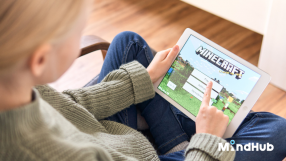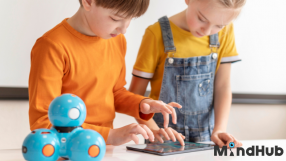
In the era of ever-developing Artificial Intelligence, children are increasingly exposed to the virtual world, with easy access to electronic devices and online platforms. Parents thus face new challenges in guiding their children to navigate healthily between the virtual and the real world, the transition between them presupposing a balanced approach and a knowledge of the solutions they can access.
With the support of early digital education, the careful monitoring of children's activity in the virtual space, the support of offline social interaction and open communication, parents can help their little ones develop in a harmonious way, equip themselves with skills necessary for the 21st century and consciously separate the two distinct worlds in which they "navigate".
We invite you to explore together a number of issues that can provide clarity and effective solutions.
1. Open and constant communication:
According to studies, parents who maintain open communication, in which they use concrete and non-judgmental explanations regarding the digital activity of the little ones, establish a concrete program in the use of technology more easily and in a balanced way. Encouraging discussions about the child's online and offline experiences can provide enlightening answers about the reasons behind the excessive use of devices or the preference to spend more time in the virtual world than the real one.
2. Early digital education:
Digital education plays a defining role in the approach to children's activity in virtual space. The idea of banning or limiting the use of technology by the little ones is not a solution; children need to understand what it means and how to use digital resources in a productive way. Programming courses using equipment and a program adapted to each age group, teaching in the form of games, translating theoretical information into clear instructions that children give to the equipment, using real-world characters can help develop critical thinking and logical skills, contributing to the formation of a healthy balance between the virtual and the real world.
3. Establishing clear boundaries:
According to research, setting clear boundaries for the use of devices and AI is crucial. It is important for parents to set rules regarding the time spent in front of screens, but also to offer children healthy and attractive alternatives in the offline world, such as outdoor activities, exercise, meeting friends or reading books. At MindHub we use time limits for each activity, including classes, playtimes, small competitions, brainstorming sessions, programming olympiad preparations, learning and development moments. Everything, so that the little ones can benefit from a framework in which they can transform from technology users to its creators.
4. Content monitoring:
MindHub recommends that parents monitor the content their children are exposed to. There are many technological tools that allow parents to filter and control access to online content, thus ensuring a safe digital experience.
5. Supporting social interaction:
The benefit of technology and Artificial Intelligence is to assist the learning process, and help children equip themselves with defining skills for their personal and professional future. However, social experience in the real world remains essential for harmonious development based on both cognitive and emotional intelligence. Children need interaction with mentors, children who share common interests, with knowledgeable parents to develop social skills. At MindHub we encourage the interaction of the little ones by working only in teams where each of them is encouraged to show their skills and knowledge. Teams work with both peers and mentors who guide them through the process.
We monitor the beneficial impact of teamwork in the preparations for national and international competitions and Olympiads in which the children attending MindHub Academy courses participate.
In conclusion, in an ever-evolving digital world, it is imperative to teach children to manage their use of technology properly. Open communication, technical education, setting clear boundaries, monitoring content and modeling behavior are key elements in this journey. The feedback we constantly provide to parents of children who attend MindHub courses is an extremely valuable resource for them in managing the relationship they have with their little ones regarding their digital activity.
Our mission is to accompany the little ones in the development of skills and abilities, using a healthy balance between the virtual and the real world, thus helping to guide a technologically aware and responsible generation.


